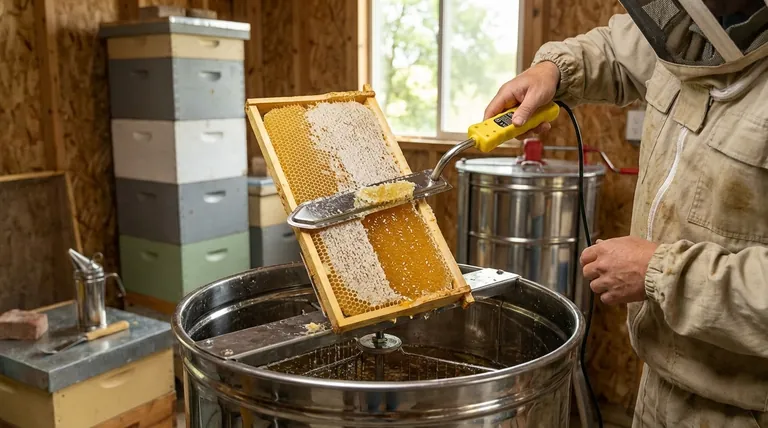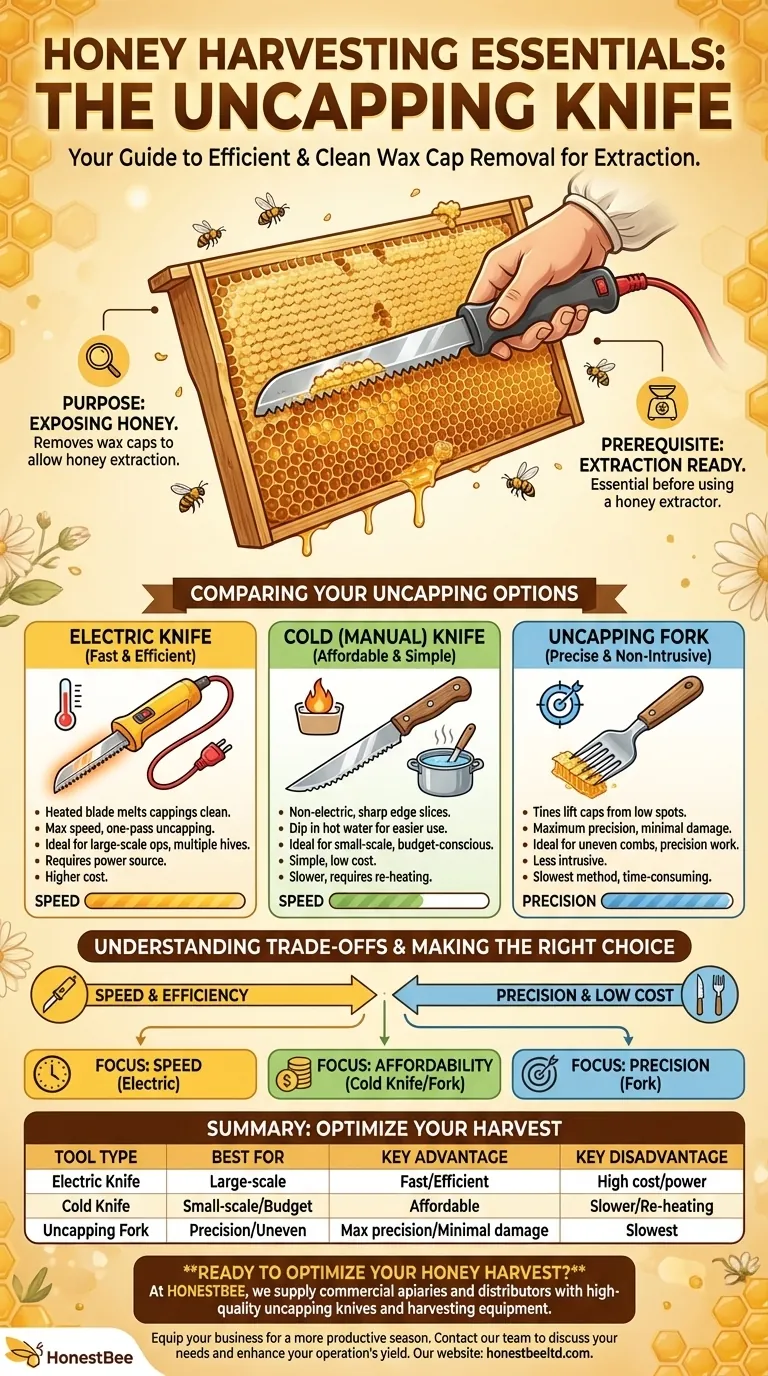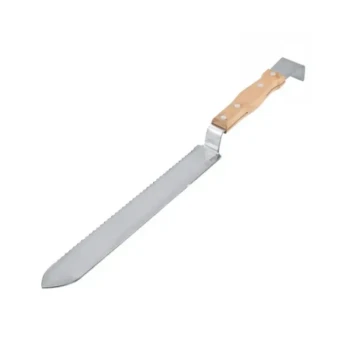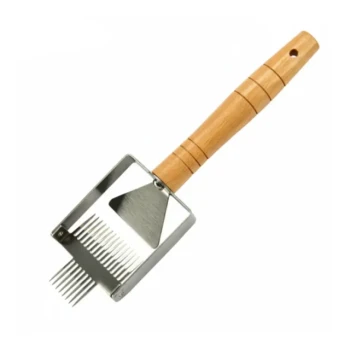In beekeeping, an uncapping knife is a specialized tool used to remove the thin layer of wax cappings that bees build over honeycomb cells. This is a critical step in the honey harvesting process, as these wax caps seal the honey in the comb. Slicing off these cappings exposes the honey, allowing it to be extracted from the frame.
The core purpose of any uncapping tool is to cleanly remove the wax seals from a honeycomb. Your choice between an electric knife, a manual knife, or a fork depends entirely on the scale of your operation, your budget, and your desired balance between speed and precision.

The Purpose of Uncapping
Uncapping is a fundamental step that stands between a full frame of honey and the final extracted product. Understanding its role clarifies the function of the tools involved.
Exposing the Honey Cells
Bees fill hexagonal wax cells with honey and then seal, or "cap," them with a fresh layer of beeswax. This capping preserves the honey, protecting it from moisture and contaminants.
A Prerequisite for Extraction
Before you can place a frame into a honey extractor, which uses centrifugal force to pull the honey out, you must first break these wax seals. An uncapping knife is the primary tool designed for this specific task.
Comparing Your Uncapping Options
While the goal is singular, the tools to achieve it vary. Each comes with a distinct set of characteristics suited to different beekeeping styles.
The Electric Uncapping Knife
An electric knife has a built-in heating element. The heated blade melts cleanly and quickly through the wax cappings with minimal effort.
This is the most efficient and fastest method, making it a worthwhile investment for beekeepers who manage multiple hives or plan to stay in the hobby long-term.
The Cold (Manual) Uncapping Knife
A cold knife is a non-electric tool, often with a long, serrated blade and a wooden handle. It relies on a sharp edge to slice through the cappings.
To make the process easier, many beekeepers dip the knife in hot water between passes. Its simplicity and low cost make it a popular starting point.
The Uncapping Fork or Scratcher
An uncapping fork, also known as a scratcher, is a fork-like tool with sharp tines. Instead of slicing, you slide the tines under the cappings and lift them off.
This tool is excellent for reaching low spots or uneven areas of the comb that a knife might miss. It is less intrusive but significantly more time-consuming than a knife.
Understanding the Trade-offs
Choosing the right tool requires acknowledging the compromises between speed, cost, and the quality of the result.
Speed vs. Precision
An electric knife offers maximum speed, allowing you to uncap an entire side of a frame in a single pass. However, it can be less precise on irregularly shaped combs.
An uncapping fork provides maximum precision, allowing you to target individual cells and low spots. This precision comes at the cost of being the slowest method.
Cost and Complexity
Electric knives are the most expensive option and require a power source. Cold knives and forks are simple, durable, and highly budget-friendly.
Impact on the Comb
A sharp knife, used correctly, provides a clean cut that does minimal damage to the underlying wax cells. A fork is often considered less intrusive because it just lifts the caps, but it can also scratch up the comb if used aggressively.
Making the Right Choice for Your Goal
Your specific needs as a beekeeper should guide your decision.
- If your primary focus is speed and efficiency for multiple hives: The electric uncapping knife is the most effective tool for the job.
- If your primary focus is affordability for a small-scale operation: A cold knife or a simple uncapping fork is a perfectly functional and economical choice.
- If your primary focus is precision on uneven combs: An uncapping fork is an essential tool, either on its own or to supplement a knife for cleanup.
Ultimately, selecting the right uncapping tool is about matching your equipment to the scale and demands of your honey harvest.
Summary Table:
| Tool Type | Best For | Key Advantage | Key Disadvantage |
|---|---|---|---|
| Electric Knife | Large-scale operations, multiple hives | Fastest, most efficient | Highest cost, requires power source |
| Cold (Manual) Knife | Small-scale, budget-conscious beekeepers | Affordable, simple to use | Slower, requires re-heating in water |
| Uncapping Fork | Precision work, uneven combs | Maximum precision, minimal comb damage | Slowest method, time-consuming |
Ready to Optimize Your Honey Harvest?
Choosing the right uncapping tool is critical for the efficiency and success of your apiary. At HONESTBEE, we supply commercial apiaries and beekeeping equipment distributors with high-quality, durable uncapping knives and a full range of honey harvesting equipment through our wholesale-focused operations.
Let us equip your business for a more productive season. Contact our team today to discuss your needs and discover how our products can enhance your operation's yield and profitability.
Visual Guide

Related Products
- Professional Electric Honey Uncapping Knife with Heated Digital Temperature Control for Beekeeping
- Professional Z-Shaped Multi-Function Uncapping Knife for Beekeeping
- Honeycomb Uncapping Knife for Apiculture
- Stainless Steel Dual Blade Uncapping Plane
- Professional Extra-Wide Uncapping Fork with Bent Tines for Beekeeping
People Also Ask
- What is the use of an uncapping knife? Master the First Step of Honey Harvesting
- How to uncap and extract honey? A Beekeeper's Guide to a Clean, Efficient Harvest
- What are the key considerations when choosing between a hot knife and a heat gun for uncapping honey frames? Choose the Right Tool for a Quality Harvest
- How to uncap a bee frame? Choose the Right Tool for a Perfect Honey Harvest
- How are honey frames prepared before extraction? Master the Hive-to-Honey-House Process



















